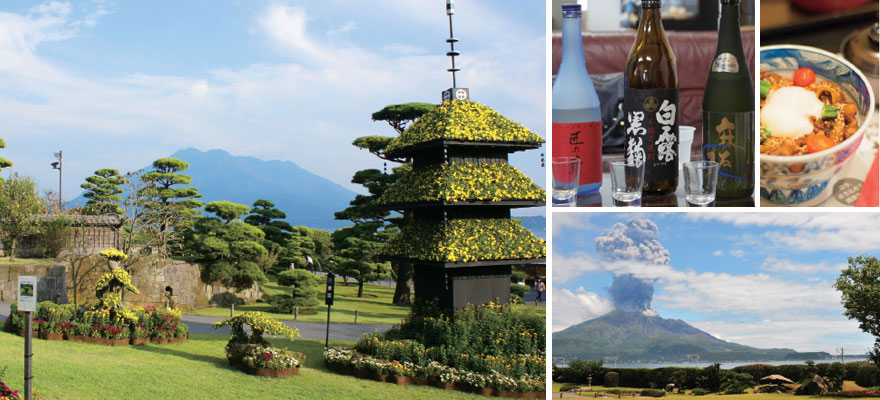Home > Highlighting JAPAN >Highlighting Japan December 2013>Japan's technological achievements
Highlighting JAPAN
47 Prefectures from A to Y
KAGOSHIMA
Drawing on the Power of the Earth

Facing the ocean at Kyushu's southern tip, Kagoshima has long formed the nexus of Japan's interaction with other cultures. Even when the nation's ports were closed during the Edo Period, Kagoshima maintained an independent link to the world through the Ryukyu Kingdom, now Okinawa. It was through Kagoshima that sweet potatoes took hold in Japan, while introduction of Western engineering precipitated the modernization of Japanese industry.
Located at the southern tip of the Satsuma Peninsula, Ibusuki City is a 95-minute bus ride south of Kagoshima Airport. The area is known for its natural sand baths, where guests put on a traditional yukata before being buried in black sand warmed by an underflow of hot spring water. The barefoot sand diggers, or suna-kake-san, carefully prepare a bed at 50 degrees Celsius, where 10 minutes of pressurized heat is said to ameliorate a variety of ailments.
Sand-steamed eggs crown an Ibusuki specialty dubbed ontamaran-don - a combination of the expressions for 'boiled egg' (ontama) and 'So good I can't stand it' (tamaran). At Aoba restaurant, a block north of Ibusuki Station, the sweet-yolked eggs of ontamaran-don are supported by tomatoes, bean sprouts, okra and soft Berkshire pork (kurobuta), the iconic meat of Kagoshima Prefecture.
Soil on the Satsuma Peninsula was considered infertile prior to the arrival of sweet potatoes. Toshiro Asechi is head of the distillery at Shiratsuyu Shuzo, which has been making imo-jochu (made by shochu) from the sweet root plants since 1730. "I think imo-jochu is synonymous with the history of Kagoshima," he grins. "People here have a long tradition called 'dareyame,' in which we relieve the exhaustion of the day with a drink of shochu. So we started making shochu using sweet potatoes that could be grown right here in Kagoshima."
Less than an hour by train to the north, the prefectural capital of Kagoshima City peers out into Kinko Bay. From here you can see volcanic Sakurajima rising out of the water just two kilometers away.
Miya Hagihara works at Sengan-en, Kagoshima City's landmark historical garden villa. "Of course, in the past this was a place of residence for the lords," she notes. And they chose this particular site because of its spectacular view of Sakurajima, appropriating the volcano as a massive piece of borrowed landscape that accents the sky with ash an average of two and a half times a day. "I see Sakurajima every day, but every day it has a very different appearance, changing from morning to noon to night. It even changes with the weather, sometimes appearing red, blue or green," observes Ms. Hagihara.
The Sengan-en area also incorporates the Shuseikan historical site, central to the sites of Japan's Meiji Industrial Revolution submitted for consideration as a World Heritage Site in 2015. While now a museum, in 1865, this simple structure stood at the heart of the first complex of Western-style factories in East Asia.
With so much having entered Japan through Kagoshima, it's a fantastic place to visit if you have any interest in Japanese history – or even if you just prefer to relax in a hot bed of sand before washing away the exhaustion of the day with some great food and a smooth cup of local liquor.
© 2009 Cabinet Office, Government of Japan






